Then began a large-scale phase in the history of our universe called the era of reionization. Scientists have long wanted to take a closer look at this mysterious and inherently inaccessible stage of space history using telescopes. No matter how you look at it, it is difficult to look into space as there are no stars or galaxies yet, and space itself is dark.
The James Webb Space Telescope, which observes distant regions of the universe — far away in space and time (thanks to the finite speed of light) — in the infrared range with its 6.5-meter mirror covered in a layer of gold, has been observing the objects we see today, as they were when The universe was less than a billion years old. The observations made with the James Webb Telescope are so precise that scientists are able to deduce this The newly formed young galaxies have started the entire reionization processwhich, over a longer period of time, made the universe transparent and light from stars and galaxies could move freely through space.
The main role in this process was played by very bright stars that formed many small and inconspicuous dwarf galaxies. The authors of the latest study compare these galaxies to specific cosmic beacons, whose light, especially intense ultraviolet radiation, slowly ionizes the neutral hydrogen-filled space. Given that the entire universe has reionized over time, these active stars and small galaxies must have had a lot of persuasive power.
Read also: Discovery of the oldest fibers of the cosmic web. A real cosmic spider web
Over the past few months, an international team of scientists has carefully analyzed detailed images of distant objects photographed by James Webb. The radiation spectra recorded in the images allow astronomers to look at older radiation that traveled through space after the era of reionization. It was the first light that could move freely in space after removing the opacity cover, which was made of neutral gas.
As you might expect, spotting small dwarf galaxies at cosmic distances has not been easy. On the one hand, they emitted extremely high-energy radiation, on the other hand, they were relatively small and located at great distances from us. That's why it took the James Webb Telescope to allow scientists to study it.
The galaxy cluster Abell 2744 has also contributed significantly to this whole process, acting as a typical gravitational lens for zooming in on images of galaxies far beyond.
During these observations, scientists determined that there were more small, bright dwarf galaxies than massive galaxies. In the era of reionization, there were up to a hundred times as many, and they were emitting four times more ionized atoms than previously thought. You could say, to paraphrase the classic phrase, that the young dwarf galaxies themselves emit ultraviolet winds that disperse the billowing dark curtains so that we can stand face to face with the Sun instantaneously.

Echo Richards embodies a personality that is a delightful contradiction: a humble musicaholic who never brags about her expansive knowledge of both classic and contemporary tunes. Infuriatingly modest, one would never know from a mere conversation how deeply entrenched she is in the world of music. This passion seamlessly translates into her problem-solving skills, with Echo often drawing inspiration from melodies and rhythms. A voracious reader, she dives deep into literature, using stories to influence her own hardcore writing. Her spirited advocacy for alcohol isn’t about mere indulgence, but about celebrating life’s poignant moments.


![Do you know who played in “The Antichrist”? Match actors' names to roles in Jerzy Hoffmann's film! [QUIZ]](https://cdn.galleries.smcloud.net/t/galleries/gf-UwGH-rB51-gxFz_znachor-1008x442.jpg)





